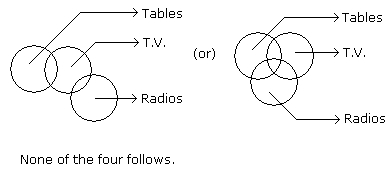Verbal Reasoning - Syllogism - Discussion
Discussion Forum : Syllogism - Syllogism 2 (Q.No. 5)
Directions to Solve
In each of the following questions two statements are given. Which are followed by four conclusions (1), (2), (3) and (4). Choose the conclusions which logically follow from the given statements.
5.
Statements: Some tables are T.V. Some T.V. are radios.
Conclusions:
- Some tables are radios.
- Some radios are tables.
- All the radios are T.V.
- All the T.V. are tables.
Answer: Option
Explanation:

Discussion:
33 comments Page 1 of 4.
Ranveer said:
9 years ago
Hi Friends,
When there is no direct relationship given between two statements then the following conclusion is always wrong. In this question, there is no direct relationship given between radio and table and hence conclusions 1 and 2 are false, 3 and 4th are very straight forward. However, you may think that there is a possibility that few radios are the table and vice versa but in that case word possible should be in conclusion (like is it possible that few tables can be radios) normally it doesn't have so I don't think you should take it as the true statement.
Thanks.
When there is no direct relationship given between two statements then the following conclusion is always wrong. In this question, there is no direct relationship given between radio and table and hence conclusions 1 and 2 are false, 3 and 4th are very straight forward. However, you may think that there is a possibility that few radios are the table and vice versa but in that case word possible should be in conclusion (like is it possible that few tables can be radios) normally it doesn't have so I don't think you should take it as the true statement.
Thanks.
Aaushi said:
10 years ago
In the above question, it is not compulsory that the remaining tables are radios.
It can be something else. In the same way, it is not compulsory that the remaining radios are tables.
So 1 and 2 not possible. And in 3 & 4 are talking about all radio and TV, whereas in question it's only about few. So E is the correct option.
It can be something else. In the same way, it is not compulsory that the remaining radios are tables.
So 1 and 2 not possible. And in 3 & 4 are talking about all radio and TV, whereas in question it's only about few. So E is the correct option.
Suresh N said:
4 years ago
According to the syllogism rule, if the given two statements are particular, then no conclusion follows. Since in the given two statements, both the statements are particular, (i.e) both begins with 'some'. Hence no conclusion follows. So, none of the four is the correct option.
(1)
Kartika said:
4 years ago
I think the given answer is right. Compare answers come from both the figures. And if both figures gives same answer then it is considered as final answer otherwise not. And in this case fig 1 and fig 2 doesn't give same answer. That's why option is E.
Ramesh said:
1 decade ago
@Sabir and @Harry are correct.
If we solve with second diagram the total answer changes. If so what is the use the second one? else if second diagram holds the value?
Then how come (E) will be the answer? What about first diagram then?
If we solve with second diagram the total answer changes. If so what is the use the second one? else if second diagram holds the value?
Then how come (E) will be the answer? What about first diagram then?
Sabir said:
1 decade ago
Please explain which figure we have to use to deduce result. Tell me the importance of these two figures. ?
According to figure 1- answer is (E) and according to figure 2 answer is different.
According to figure 1- answer is (E) and according to figure 2 answer is different.
Rajkasam said:
1 decade ago
Please let me know which is correct answer, and which diagram must be used to decide the answer.
According to 1st diagram option D is correct but according to 2nd diagram option varies.
According to 1st diagram option D is correct but according to 2nd diagram option varies.
Faithful said:
9 years ago
@Sanjay.
In that case, the option of only 1 and 2 will be the correct answer. The best way to approach this is to apply the Venn Diagram Method.
I totally agree with your answer @Bala.
In that case, the option of only 1 and 2 will be the correct answer. The best way to approach this is to apply the Venn Diagram Method.
I totally agree with your answer @Bala.
Sanjay said:
9 years ago
For the same question stated above what if they had given an option as ("only 1 and 2") and also the option ("None of These ") what would have been the answer then?
Bala said:
1 decade ago
Answer is correct. According to figure 2 we get conclusion 1 & 2 follows but its not in option (only 1 & 2 follows). So none of the four is correct.
Post your comments here:
Quick links
Quantitative Aptitude
Verbal (English)
Reasoning
Programming
Interview
Placement Papers